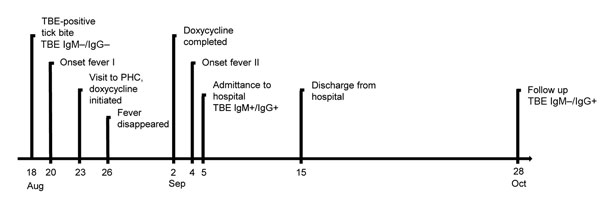Volume 22, Number 8—August 2016
Dispatch
Human Tick-Borne Encephalitis and Characterization of Virus from Biting Tick
Figure 1

Figure 1. Time course of tick-borne encephalitis (TBE) in a 67-year-old man in Sweden, 2011. A classic biphasic onset of symptoms is shown. PHC, primary healthcare center.
Page created: July 15, 2016
Page updated: July 15, 2016
Page reviewed: July 15, 2016
The conclusions, findings, and opinions expressed by authors contributing to this journal do not necessarily reflect the official position of the U.S. Department of Health and Human Services, the Public Health Service, the Centers for Disease Control and Prevention, or the authors' affiliated institutions. Use of trade names is for identification only and does not imply endorsement by any of the groups named above.